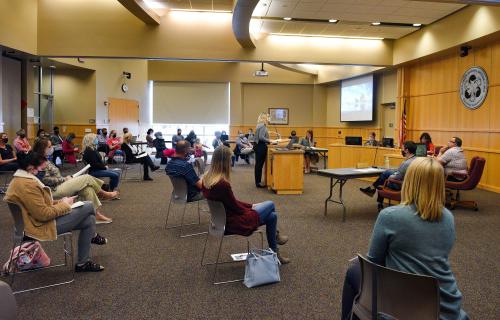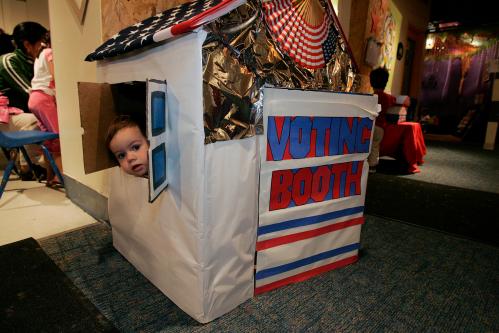Historically, most local school board meetings have been sleepy affairs. Board members talk about facilities upgrades and operating expenses, with an occasional public comment or acknowledgement of a retiring teacher to spice things up. Contentious issues arise, but the typical school board meeting is a good match for its public-access television home.
But recent school board meetings have been anything but sleepy. Boards across the country are seeing fiery protests over school reopening plans, mask mandates, critical race theory (CRT), and gender identity. Social media is littered with clips of community members screaming at elected officials, espousing conspiracy theories, and making the occasional Nazi salute. We’ve seen threats directed at school board members, a sharply worded (and later-rescinded) letter from the National School Boards Association likening these threats to domestic terrorism, and, according to data from Ballotpedia, a spike in the number of school board recalls.
This turbulence has, of course, created immediate challenges. School governance is hard these days, with boards tackling complex questions about public health, education, and budgeting amid a great deal of uncertainty. At minimum, what’s happening across the country is distracting; often times, it’s been downright alarming. But these outbursts will have longer-term effects on school boards that are more troubling: They will change who runs for local school boards and who wins those seats, in many cases for the worse. And this will be happening right as school districts are seeing a major infusion of federal funds, with board members poised to make high-stakes decisions about how schools respond to the pandemic’s impacts.
We’re already seeing changes in who runs for their local school board. Candidates emboldened by recent protests are turning their elections into referenda on their adopted hot-button issues—issues that overshadow the real needs of students. Some are finding clear paths to victory, with worn-down incumbents and wary potential challengers staying out of the fray.
However, firebrand candidates can win contested elections, too, even in places where their views are far outside the mainstream thinking. The reason is that local school board elections aren’t like elections for other offices. In a high-profile election for, say, president or governor, most voters are familiar with candidates and turnout is relatively high. They might lean on party identification as a signal of which candidates align with their preferences. Fringe candidates can win, but it’s rare to see a far-right candidate win a race in a left-leaning jurisdiction or vice versa. Higher turnout and greater familiarity buffer against surprising outcomes.
Most local school board elections don’t have those buffers. The National School Boards Association cites “discouragingly low” voter turnout rates, often in the 5% to 10% range. Turnout tends to be especially low in areas with “off-cycle” school board elections that are held on different days from state and national elections. And information about candidates, like party identification, can be hard to come by.
As a result, school board elections are susceptible to the whims of a small number of voters. Researchers have documented how small-but-organized groups, likes teacher unions, affect school board election outcomes (and the policies that follow) by turning out voters. In the case of unions, that has meant more teacher-supported candidates winning seats and negotiating for higher teacher salaries. The consequences of, say, CRT hawks taking control of school boards would be very different. There’s reason for concern about both how outside-the-mainstream board members would handle the issues of today and what they might choose as the issues of tomorrow.
Consider what is on, or being added to, school board members’ plates these days. There are health questions related to COVID-19 vaccines and safety precautions, along with many other pandemic-related challenges, from sharp enrollment declines to impacts on students’ social-emotional and academic well-being. The pandemic also brought unprecedented levels of federal funding to local school boards via the American Rescue Plan, with potentially more to come. Local school board members have considerable discretion over spending decisions, and this next wave of board members will have a lot to say about how these new resources are used (and not used). Then, of course, there are culture war issues, such as battles over CRT and, increasingly, banning books from school libraries. Many of these issues have a civil rights angle, such as the increasingly hostile policies toward transgender students, which often put already disadvantaged kids unfairly in the crossfire.
These issues have ramped up quickly in ways that have been difficult to foresee. If today’s most extreme school board protesters become tomorrow’s school board members, chances are that we’ll see new, ugly, unexpected issues bubbling up around the country, with potential to inflict particular harm on the most vulnerable students. Those are students whose interests are often least represented in policy discussions.
In fact, the United States has longstanding issues with school board representation. The vast majority of school board members—and a disproportionate share of school board election voters—are white, even though white students no longer comprise a majority of the U.S. public school population. A recent study of this racial mismatch found that areas with larger gaps in voter and student racial demographics also tend to have larger racial test score gaps. Board representation is likely a factor.
Policy reforms could improve board representation and safeguard against takeovers by small groups with positions well outside the mainstream of their communities. Moving local elections to the same days as state and national elections can increase and diversify turnout. Electing members by ward rather than through at-large elections can, under certain circumstances, improve minority representation. And the types of voting rights protections being discussed across the country, such as ensuring adequate polling locations and hours, would have positive implications for school board elections.
All of that said, the most immediate way to affect the outcomes of school board elections is to vote. Many school districts in states across the nation are holding elections this month, with a large share of those on Nov. 2. These are high-stakes contests in which a small number of votes is often decisive. If Americans don’t start voting in these races, we should expect unpleasant surprises to come.






Commentary
It’s time to start voting in your local school board elections
November 1, 2021